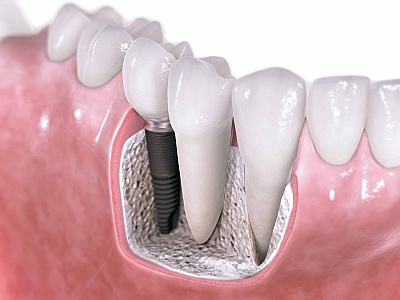A dental implant is the replacement of the root of a natural tooth, which consists of a root and a crown. The part of your tooth that you see and eat with is the crown. The tooth does not end where it meets the gum, but rather extends under the gum and into the jaw bone. This extension is the root which anchors the tooth in the mouth.
When you lose a tooth, both the root and the crown are lost. In order to replace the crown, a new ‘root’ is needed to hold and support it, and that is what a dental implant serves to do.
The diagram below is split to show the natural on the left side, and the implant and crown replacement on the right side:
Brånemark System® Dental Implants
Essentially, a dental implant is a high-grade, titanium screw that is fitted into the jaw to act as the root of a tooth to support a crown, a bridge or a denture. The implant is placed in a painless procedure under local or general anaesthetic, depending on each individual case.
Titanium is a metal that is completely inert in the human body and has been used for decades in many scopes of medicine. Once an implant is placed in the bone of the jaw, it usually needs between three to six months to be secure within the bone. The process by which the bone attaches and secures itself to the implant surface is called osseo-integration.
The exact time needed for osseo-integration to effectively occur is dependant on each individual patient, and specifically the quality and quantity of bone in the jaw where the implant is placed. Ideally the crown or any other prosthetic work that will be held by the implant should only be placed once osseo-integration has occurred.
Dental implants have offered many patients a variety of treatment options that were once impossible. If you want to know more about this or any other procedure or if you may be a candidate for such treatment please don’t hesitate to contact us.
